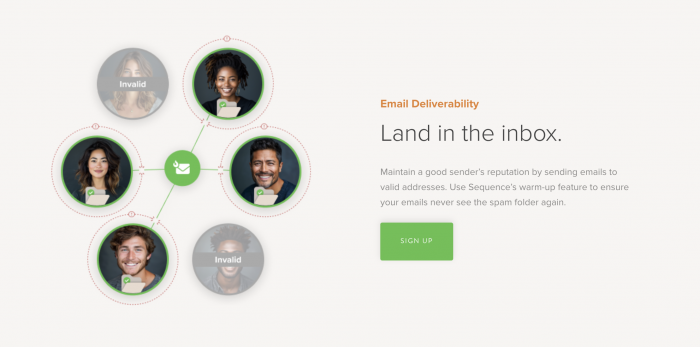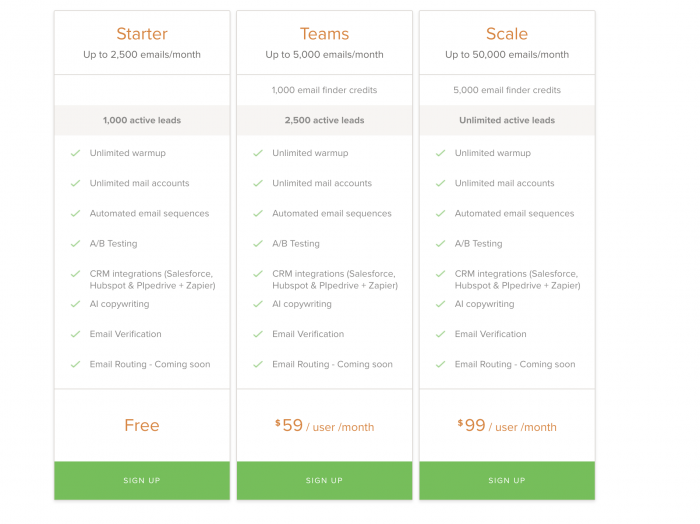Cold emailing is an age-old approach that can deliver strong results, pulling in new leads and customers. There’s a key caveat, though; it must be handled properly. Due to poor tactics, in fact, lots of cold emails can be flagged as ‘spam’ and consigned to the trash, never to be read by potential customers. If your emails are to avoid this fate, you need to plan.
But what’s the trick to sending successful cold emails? It might sound a bit silly, but the best way is to… warm them up! Here’s how warming up emails can help ensure your outreach campaigns make a bigger splash.
“Warming up emails”: Definition and benefits of this approach
Warming up emails is the process of making your mail less likely to trigger spam filters. The tactic involves sending emails in small batches and building up a positive email reputation.
To help illustrate this, imagine two scenarios.
In scenario A, a salesperson comes to your house out of the blue, trying to sell their product. You’ve never met the seller before and you don’t recognize their company. In scenario B, a seller from a familiar brand comes to your house. You’ve had previous dealings with the brand and have a favorable view of their products.
When comparing these scenarios, which scenario is most likely to win your trust as a customer? As you probably guessed, the answer is B. You, the customer, know that the seller comes from a trustworthy brand and aren’t worried about any tricks or scams. Email service providers (ESPs) use this same logic when assessing incoming mail.

If an unknown email address is sending lots of emails, they’re more likely to be blocked. If, on the other hand, the email is “warmed up” properly beforehand, the chances of it going to the spam folder are massively reduced.
But warming up emails also helps you in other ways. By sending a smaller number of emails, you can focus on building relationships with individual clients. This happens because you tailor your messaging in a way that is likely to generate a more positive response from recipients.
And when you create more interactions, you’ll build a stronger reputation with ESPs. With commitment, you can change a neutral reputation to a positive one – all through the process of warming up your emails.
Step-by-Step Guide to Warming Up Emails
Wondering where to begin with warming up your emails? Follow each of these best practices step-by-step.
1. Decide if automation is right for you
There are two approaches to warming up emails. You can handle the warm-up process manually, or you could use an automated solution. Let’s look at both options.
Manual warm-up
The goal of email warm-up is to gather positive responses from recipients. But, there are no rules about who these recipients need to be. If you’ve got multiple personal email accounts, why not send yourself a few emails?
Of course, it’s unlikely that you’ll have enough personal accounts to build a positive reputation. Once you’ve exhausted your accounts, move on to messaging friends and family. Let them know in advance that you need to send a quick response to your mail. Make sure that, if your messages are ending up in junk folders, then the recipients move them back to their main inbox.
Lastly, as mentioned, warm-up is a chance to establish relationships with new customers. Try to avoid being too pushy or ‘salesy’ in your approach. Treat your emails as a chance to spread information about your brand or products. For instance, If you’re a B2B business offering software as a service, you might create a newsletter covering ‘what are SaaS tools?’.
Automated warm-up
The second option is to use an email warm-up tool to send emails to you. This tactic can bring quicker rewards, it’s also, however, more risky. The wrong tools could harm, rather than hinder your reputation.
That’s why, if you choose an automated solution, it’s important to weigh up your options carefully. To help guide your decision, consider the following points:
- Scalability – The tool should offer a variety of pricing options to meet your individual needs.
- Compatibility – Warm-up software should be capable of sending emails to many different email providers.
- Trust – The tool should be sending mail to real email addresses instead of bots (mail sent to bots is more likely to land in spam).
- Email engagement – The solution should ensure that email recipients are responding to sent mail.
For a reliable automated solution, why not try email sequences tool? The tool contains each of the features listed above and is even free if you’re sending fewer than 2,500 emails each month.

2. Update your approach
The traditional approach to warming up emails is simple. Send a small number of emails and build an email reputation. If you’re viewed as trustworthy, the ESP is less likely to block your mail when sending mass cold outreach campaigns.
Unfortunately, this tactic has proven to be less effective in recent years. ESPs have altered their approach to classifying ‘trustworthy’ mail. The new strategy is to look more closely at the reaction of recipients to your mail. Are they opening or responding to emails? Do they frequently interact with emails from a particular sender?
This has meant that organizations have had to rethink their tactics when warming up emails. Salespeople now focus on gathering positive responses to their mail (we’ll look at how you can create a successful email warmup strategy later).
3. Don’t jump straight in
Whilst it’s possible to jump straight into cold email campaigns, it isn’t recommended. Yes, you might get some positive responses to your mass emails, but others won’t. Each time your email is flagged contributes to a negative reputation. A few negative responses, and you could be back to square one.
Email warmup usually only takes a couple of weeks. And remember, you can always supplement this downtime with other forms of lead generation. For instance, you might focus on telecommunications SEO, or door-to-door sales.
By putting a few weeks into email warmup, you put your eventual outreach campaign on a much stronger footing from the get-go.
4. Start with segmentation
Segmenting is the process of breaking your audience into smaller groups with shared characteristics. Your client base may cross different demographics, regions, and professions. Segmentation helps you to understand the different subsets that make up your customers. Each of these could respond quite differently to a standard email.
Incorporating strategies like integrating a Facebook lead form to email can also help tailor your approach to different segments.
It’s also a good idea to create personas for different client types. Think about the tone, style, and messaging that each would respond positively to. You can then tailor your warm-up mail to the different segments you’ve identified.
5. Make content exciting (but don’t overdo it with visuals)
Salespeople know that plain text isn’t likely to inspire many sales. Customers like exciting, eye-catching content, and they’re not likely to read walls of text. To succeed, you need to include interesting visuals in your email, such as images or videos.
Unfortunately, too many images can also lead to your mail being blacked. Scammers use visuals because they know recipients are more likely to click through. When an ESP receives an email from an unknown sender containing images, it is more likely to be viewed as spam.
You can create a template (a set layout for emails, containing text, images, and links) for use in your later outreach campaign. This can help you prove that your images and links are safe by generating positive responses. So, when you use the template again on a larger scale, it’s less likely to be blocked.
6. Send a variety of emails
If every email you send is the same, receipts will become less responsive. To keep your mail new and fresh, try sending a variety of messages. For instance, one batch of emails could focus on product information, the next on special offers, and another on the latest news. Don’t forget to incorporate personalized messaging.
7. Follow the data
How are your warm-up emails performing? It’s important to regularly review their success. If recipients aren’t responding or favoriting your emails, you’ll need to change your approach.
Identify key metrics that will help you judge success. Paying attention to metrics such as ‘email reply rate’ or ‘inbox rate’ is usually important, but there might be other, more specific metrics that are particularly appropriate to your brand or business.
In summary
Don’t be put off by some statements – cold outreach is still an effective tactic in sales. Those that lack success usually fail because they don’t lay the groundwork. Their emails are blocked by ESPs and customers don’t get a chance to see them. This could have been reversed if they had simply put more time into warming up emails.
If you’re unsure where to start, take another look at our best practices. Following each step will help boost your chances of a successful email warm-up. And remember, you can speed up the process with the right email warm-up tool. Why not sign up and see how Voila Norbert’s email sequencing tool with warm up capabilities can help kickstart your cold outreach?
*** This is a guest post from Nick Brown. Nick Brown is the founder & CEO of accelerate agency, the SaaS SEO agency. Nick has launched several successful online businesses, writes for Forbes, published a book and has grown accelerate from a UK-based agency to a company that now operates across US, APAC and EMEA. This is his LinkedIn ***